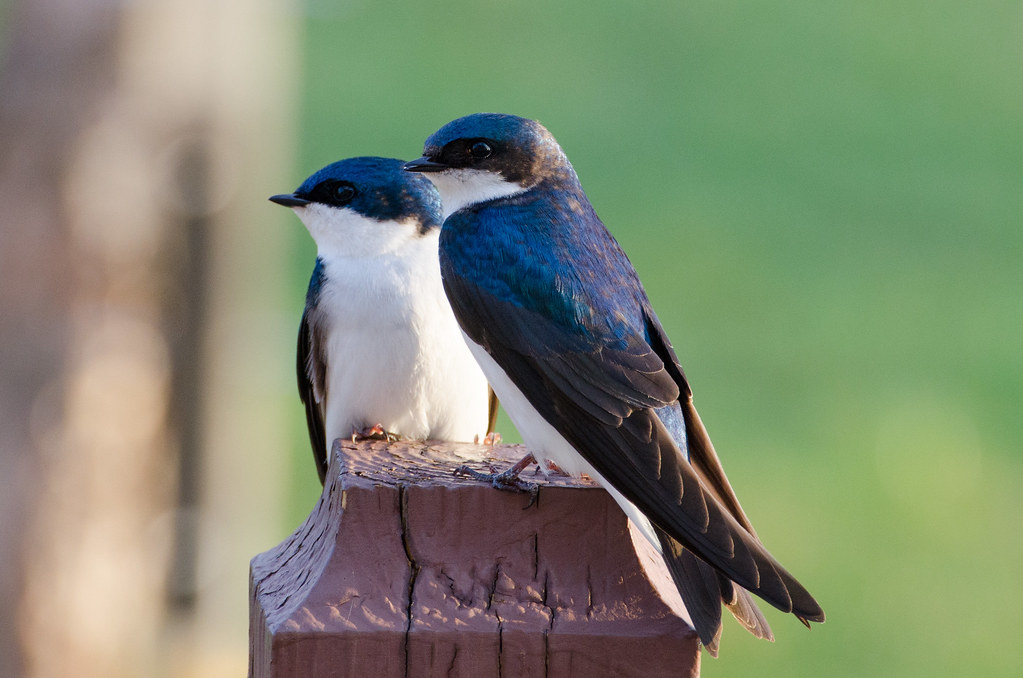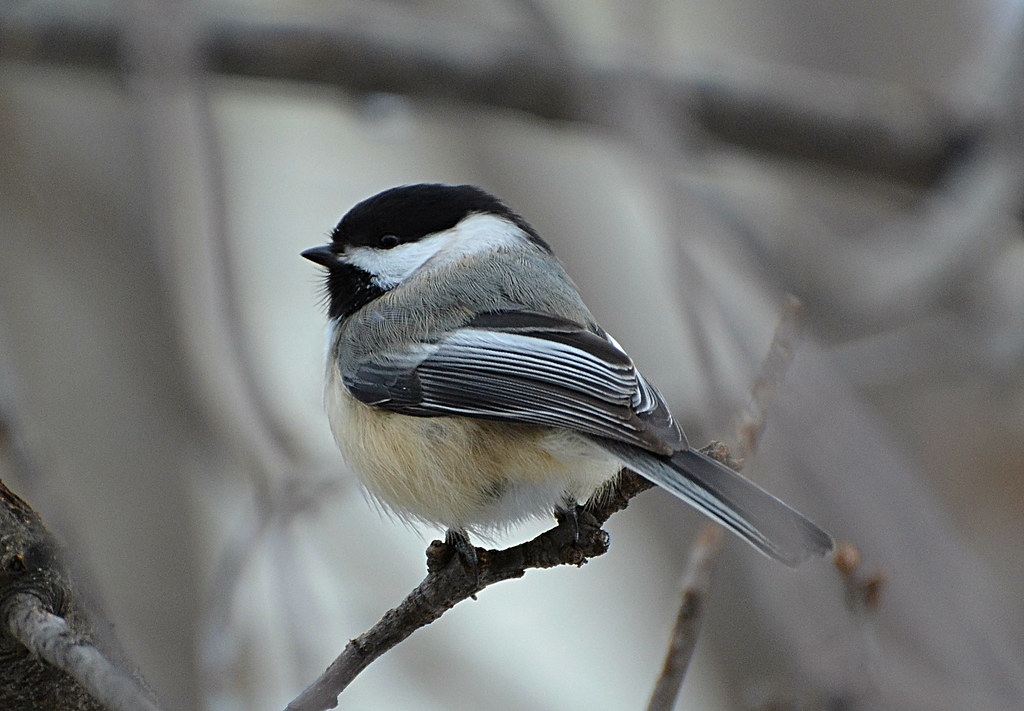
Bluebirds are “secondary cavity-nesters,” which means they build their nests inside of holes that have been made by other birds (like woodpeckers). If they can find them, bluebirds will even build nests inside of rotted out fence posts, or in natural holes in dead trees.
As you probably know, bluebirds also build nests in bluebird houses (AKA nest boxes). The great thing about putting up a nest box is that it allows us to attract bluebirds to our own backyards! But there are a bunch of other cavity-nesting birds that will also happily choose your bluebird house as the place to build their nest. So, what other birds nest in bluebird houses?
Here are ten other species of birds that you might find nesting in your bluebird nest box:
- House Sparrow
- House Wren
- Carolina Wren
- Tree Swallow
- Violet-Green Swallow
- Black-capped Chickadee
- Tufted Titmouse
- Ash-throated Flycatcher
- Brown-headed Nuthatch
- European Starling
The above photo by Andrew Weitzel is licensed under CC BY-SA 2.0

Below I’ll give an overview of each of these birds – what they look like, where to find them, and how to identify their nests and eggs. Plus, I’ll discuss which of these species are native birds vs. non-native birds in North America.
Let’s start with the most common bird that you might find nesting in your bluebird house.
1. House Sparrows

House sparrows were originally introduced to New York in 1851 from the UK, and today they are one of the USA’s most common songbirds. According to the Cornell Lab of Ornithology, after the house sparrow arrived in Brooklyn in 1851, the species made it all the way to the Rocky Mountains by 1900 (source).
House sparrows’ ability to adapt to different nest sites, their relatively aggressive nature, and the fact that they thrive in urban and suburban environments has allowed house sparrows to spread across the continent rapidly.
Today, the house sparrow is, without question, the bluebird’s number one competitor for nest boxes. They fiercely compete with bluebirds for nesting sites, killing young bluebirds, adult bluebirds, and destroying their eggs. Since house sparrows are smaller than bluebirds, they can fit inside any entrance hole that bluebirds can use, so they can’t be easily deterred from nest boxes like other larger birds. Because of this, they’re not a bird that most bluebird enthusiasts look on favorably.
Fortunately, since house sparrows are a non-native and unprotected species, you CAN legally remove house sparrow nests and eggs from nest boxes in the USA to deter them. Here’s what to look for in your nest box…
House Sparrows: Nest and Egg Identification

The male house sparrow will build a tall nest out of dry grasses and vegetation, lined with miscellaneous materials like string, feathers, animal hair, etc. The nest will have a slightly messy appearance, when compared with a bluebird nest, and it will usually reach to the top of the nest box when it is complete.
Regarding their eggs, house sparrows typically lay four or five grayish-white eggs speckled with brown spots. See below.

Most bluebird landlords, including myself, recommend removing sparrow nests and eggs when you find them. This step to deter house sparrows will go a long way in making your backyard more attractive to bluebirds.
Now let’s look at a common bluebird house guest that is native to North America.
2. House Wrens

House wrens are a common song bird across most of the western hemisphere. They have small, brown bodies with a long beak, perfect for catching insects. They often nest in bluebird boxes that are mounted close to tree lines or near brushy areas. They seek cover and protection from brushy areas, so these spots are particularly attractive to them.
Wrens are very territorial and sometimes pierce bluebird eggs with their long beaks if they feel that bluebirds are infringing on their territory. For this reason, many bluebird landlords dislike house wrens and suggest discouraging them from using bluebird houses (source).
Since wrens are a native species to North America and are protected by US law, you should never remove active house wren nests or eggs from nest boxes. But luckily, wrens don’t usually start building nests until early May. By that time bluebirds will hopefully have built their first nests of the year and staked out their territory.
Here’s what to love for in your nest box…
House Wrens: Nest and Egg Identification

A house wren nest is hard to miss when you see it. They build very tall nests, mainly of sticks and twigs, that reach all the way up to the opening of the nest box. If you see a nest made of twigs in your bluebird house, there’s almost no doubt – you have a house wren.

One interesting thing about wrens is that they line their nests with a “nest cup.” At the top of the nest there will be a nest cup made of softer grasses and feathers. This is where the female will lay her spotted, reddish-brown eggs. If this soft nest cup is missing, and the box is just filled with a messy bunch of twigs, it is likely a “dummy nest,” and not an active nest.
Male house wrens usually fill multiple nest boxes and cavities with these dummy nests to discourage competitors from nesting near them. If you are sure that your nest box contains a wren’s dummy nest, feel free to remove it in order to free up the box for bluebirds.
As long as you’re leaving active nests alone, don’t feel bad about removing dummy nests or discouraging wrens from using your bluebird houses. Wrens can build nests in almost any cavity or small hole imaginable (in old boots, flower pots, etc.). They won’t be harmed by not using your nest box.
3. Carolina Wrens

The Carolina wren, a relative of the house wren, is a small, cinnamon-colored bird with a light stomach, upturned tail, and a white eyebrow stripe. This bird is common in the entire eastern half of the United States, as well as in parts of Canada and South America.
Unlike house wrens, Carolina wrens do not usually destroy the nests or eggs of eastern bluebirds (source). So, these birds are a slightly more welcome guest to bluebird houses, since they don’t post as much of a threat to bluebirds’ safety.
Here’s what to look for in your nest box…
Carolina Wren: Nest and Egg Identification

Carolina wrens build a slightly messy nest of dry grasses, twigs, bark, weeds, and moss. Their nests are usually domed up to the entrance hole, and active nests will have a soft “nest cup” made of hair, fur, feathers, and other soft materials. Eggs are usually white or pale pink, larger than house wren eggs, and speckled with rusty, reddish-brown spots.
4. Tree Swallows

Tree swallows are a water-loving relative of the barn swallow that inhabit the northern half of the US and most of Canada. These particular swallows are cavity nesters and often compete with bluebirds for nest boxes that are placed near ponds or lakes.
These white-bellied birds with iridescent-blue backs are famous for gliding swiftly through the air, catching airborne bugs for food. Since bluebirds catch insects on the ground and tree swallows catch bugs in the air, the two species don’t compete much for sustenance. But tree swallows love to nest in the same types of nest boxes as bluebirds, so they are frequent competitors for bluebird houses.

As they are a native species, and significantly less aggressive than even bluebirds, tree swallows should be a welcome nester at your bluebird house. There are even methods of “pairing” nest boxes close together so that bluebirds and tree swallows can nest peacefully near each other without causing territory clashes. Check out the Tree Swallow Project for more information on reducing competition between bluebirds and swallows.
Here’s how you’ll know you have tree swallows in your nest box…
Tree Swallows: Nest and Egg Identification

Tree swallow nests look similar in many ways to bluebird nests. They are clean looking and made mostly of dried grass. Sometimes they add pine needles and other various dried vegetation. The main marker of a tree swallow nest, however, is that it will be lined with feathers, usually white feathers from other birds. The feathers provide a soft place for the female to lay her eggs, of which there will usually be 4-7 pale pink or white ones (source).
5. Violet-green Swallows

Next on the list of other birds that nest in bluebird houses is the violet-green swallow, a close relative of the tree swallow. This particular bird, which nests in the western US and Canada, is extremely fast-flying, has a deep, sea-green color on its back, and distinctive white markings on its cheeks and rump.
You might find Tree Swallows nesting in your bluebird house if you live in the western half of North America and place your nest box near a lake or pond.

Now, here’s what to look for in your nest box…
Violet-green Swallows: Nest and Egg Identification

Violet-green swallows will build a relatively loose, shallow nest in your box, consisting mainly of dried grasses, twigs, and feathers. They usually lay between 4-6 pure white eggs per brood (source).
6. Black-capped Chickadees

Black-capped chickadees are a bird that you might see often at your bird feeder. They have a beautiful gray and white body with a signature black “cap” and “bib” around their head and chin. Listen for a loud chicka-dee-dee-dee-dee call and you’ll know one of these birds is nearby.
Besides visiting your feeder, black-capped chickadees also happen to be cavity nesters and might take up residence in your bluebird house. Apparently, they are more attracted to nest boxes with wood shavings placed inside, and they are fine nesting in wooded areas (source). Keep this in mind if you’re specifically interested in attracting chickadees.
Here’s what the black-capped chickadee’s nest and eggs will look like…
Black-capped Chickadee: Nest and Egg Identification

The female black-capped chickadee builds a small, cup-shaped nest out of moss and other materials. She then lines the nest with fur to make a soft nest-cup. If you find a rabbit-fur lined nest in your bluebird house, it is likely a chickadee nest.
According to the Cornell Lab of Ornithology, chickadees can lay anywhere from one to thirteen eggs per brood, and their eggs are typically white with reddish-brown speckles (source).
7. The Tufted Titmouse

Next on the list of other birds that nest in bluebird houses is the tufted titmouse. This bird is common to deciduous forests of the eastern United States. The tufted titmouse has a strong beak, large black eyes, gray back, and a tell-tale crest on the top of its head. You might occasionally see this bird at feeders looking for sunflower seeds.
While they’re not a common competitor for nest boxes, titmice will occasionally nest in an unused bluebird house. Here’s what to look for…

Tufted Titmouse: Nest and Egg Identification
Titmice build a cup-shaped nest of grasses, bark, and twigs, then they line the nest-cup with soft materials like cotton, wool, and most notably, animal hair. Titmice are famous for using hair in their nests, and sometimes even pluck hair right off of other live animals!
If you find a nest with eggs, look for arounds 3-9 white eggs, speckled with reddish-brown markings. (source)
8. Ash-throated Flycatchers

The next on the list of birds that nest in bluebird houses is the ash-throated flycatcher. This native, desert bird is found mainly in the south-western US and parts of Mexico. The ash-throated flycatcher has a brown body, fanned tail, and famously goes without drinking any water. It gets all the liquid it needs from the insects and spiders that it eats (source)!
If you’re a bluebird landlord in the southwest, here’s what to look for in your nest box to know you’ve attracted an ash-throated flycatcher…
Ash-throated Flycatcher: Nest and Egg Identification

Ash-throated flycatchers build a cup-shaped nest out of pieces of bark, twigs, dry grasses, and cow manure. They might even use snakeskin in their nests, but this only occurs in about 5% of nests.
The nest will be lined with hair, feathers, fur, cotton, and other soft materials, and the female will lay between 2-7 creamy white eggs with reddish-brown blotches and streaks (source).
9. The Brown-headed Nuthatch

The brown-headed nuthatch is a native species in North America and is mainly found in mature pine forests in the south-eastern United States. This bird has a blue-gray back, white belly, and a distinctive brown head. While these nuthatches are mostly seen high in the trees, they can also be attracted to suet feeders, and they occasionally choose bluebird houses as their nesting site.
Brown-headed nuthatches, which look similar to the white-breasted nuthatches of the Midwest, are apparently more inclined to use bluebird houses than their white-breasted cousins. So, if you live in the south-eastern US, particularly near a pine forest, here’s what to look for in your nest box…
Brown-headed Nuthatch: Nest and Egg Identification
The Brown-headed nuthatch builds a small nest out of cotton, feathers, pine-seed wings, and strips of bark. They usually lay 3-7 cream-colored eggs that are speckled with reddish-brown spots.
10. European Starlings
![European Starling [49/366]](https://live.staticflickr.com/1483/25022465552_10525f1234_b.jpg)
Now, last on the list is one of the least popular birds that nest in bluebird houses – the European starling. Starlings are a non-native species in North America, originally released in New York in 1890 by a group of Shakespeare enthusiasts who wanted the US to have every bird ever mentioned by Shakespeare (source).
European starlings, which started as just 100 birds, now have a population of over 200 million from Alaska to Mexico and are often considered pests due to their aggressive nature and general abundance. Starlings fiercely compete with bluebirds for natural nesting cavities, and they are likely responsible for much of the eastern bluebird’s population decline in the early 1900s.
Thankfully, due to starlings being slightly larger than all three species of bluebirds, if you have a bluebird house with a properly sized entrance hole, starlings will not be able to enter. Click here to read the article I wrote about the proper entrance hole size for bluebird houses.
If somehow a starling does nest in your bluebird house, just know that starlings are not a protected species in the US, so you can legally remove their nests and eggs if you find them. After removing their nest, I suggest checking the entrance hole size on your bluebird house and, if the hole is too big, installing a properly-sized predator guard over the entrance.
If you suspect starlings are nesting in your bluebird house, especially if it’s an older nest box with an enlarged entrance hole, here’s what to look for…
European Starlings: Nest and Egg Identification

At first glance, European starling nests look strikingly similar to bluebird nests. Starlings use pine needles and dry grasses to build a cup-shaped nest, similar to the nests of eastern bluebirds. The difference is that starlings usually have the nest cup located farther back in the box than bluebirds, and starlings will include feathers, cloth, string, and even pieces of trash in their nest materials. Bluebirds will rarely include these things.
Starlings lay 3-6 eggs per brood that are usually blueish or greenish-white in color.
As I mentioned before, the best and easiest way to deter starlings is by having a properly sized entrance hole on your nest box. You can click here to view the nest boxes that I recommend, or click here to see plans for building your own nest box to the proper specifications.
Conclusion
While this is not an exclusive list, these are ten of the most common birds that nest in bluebird houses throughout North America. If you want to learn more about how to attract bluebirds to your own backyard, click any of the following links below to read relevant articles from this website. Thanks for visiting Bluebird Landlord!


